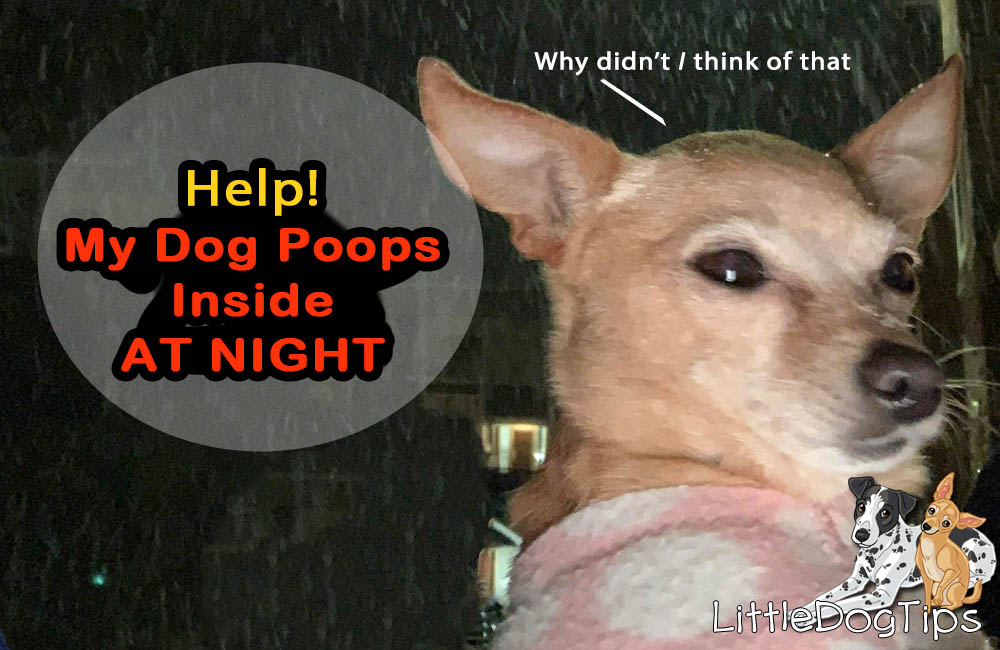
Do you have a nighttime ninja pooper?
It’s not uncommon for dogs to seem totally housetrained during the day, while their humans are awake, then sneak around at night leaving presents for their pet parent to discover in the morning.
With any luck, you’re not finding your dog’s nighttime accidents by stepping in them before you put on your glasses/socks/shoes. And if you are… I can’t imagine the frustration.
Nighttime pooping and peeing can be stopped with a few adjustments of your routine and some quick refreshing with your dog’s training. You can look forward to better mornings soon, I promise. No more rude awakenings!
What Time Is Dinnertime?
Though transit times vary, you can typically expect your dog to poop shortly after mealtimes.
It takes about 8-12 hours for food to move through your dog, from beginning to end. Your dog’s next poop is likely the result of their meal before their last.
Some dogs poop and pee more frequently than others.
Cow reliably poops three times per day, while Matilda, just once. This has changed over time on different diets, but has become pretty predictable. I know Cow will poop immediately first thing in the morning, while lunchtime is poop time for Matilda.
It’s much, much easier to learn your dog’s poop and pee schedule when you take them for walks, rather than let them out in backyard to do their business.
It might not be feasible to take your dog for walks, or to keep a close eye on their deposits, especially if you’re not their only caretaker. Just keep your eyes open for any patterns, and keep your family members in the loop so you can learn their schedule together.
The best time to feed your dog depends on your schedule and theirs.
I prefer feeding twice daily, at around 7AM and 5PM, with occasional snacks around lunch or right before bed. So it makes sense that early mornings coincide with the time Cow’s dinner would take to make its exit.
If she were waking me up at night to go out, or having accidents, I’d probably feed dinner later so it would be a longer time until she needed to poop.
Conversely, feeding meals earlier can be helpful. You might have to experiment to see what works best for your dog. If they have a quick tummy transit time, an early dinner might be on its way out before bedtime.
Sneak-Stopping Sleeping Arrangements
A dog that has accidents in your home should not have free range while you’re asleep.
You can crate your dog at night. You’ll need to place their crate close enough that you are able to hear them bark or stir, that way you can take them out for a nighttime potty break. If your dog has never been crate trained, they might hate being crated at night, but if you make it cozy, make sure all of their needs are met, and take them out when they do bark or whine, they’ll likely adjust quickly.
If you’d prefer not to use a crate, you can keep your dog in your bedroom so you can hear them scratch the door, bark, whine, or otherwise communicate when they have to go out.
Now, you might not be keen on the idea of waking up to take your dog outside, but it’s much preferable to cleaning up accidents. In time, you can shift their potty breaks outside of your sleeping hours.
How Does Your Dog Ask for a Potty Break?
Keep in mind that all dogs occasionally need to go outside in the middle of the night.
Even after you shift their potty schedule so they sleep all night, instead of having to hold it in, they may eventually suffer indigestion, have a late-night treat or long drink of water, or otherwise just need to go out.
Some dogs struggle with potty-training when we take them out on a schedule, but they never learn to let us know when they need to go outside. They will either hold it until it’s time for a potty break, or just have an accident.
Your dog might naturally bark, whine, stare at you, sit by the door, or scratch when they have to go out. If your dog does not communicate with you, you can use potty bells or a talking button to help them find their voice.
Can I Just Use Potty Pads at Night?
It’s perfectly acceptable to use potty pads intermittently, in combination with taking your dog outside if that’s what works for you.
It may not be safe or possible for you to take your dog out at night, depending on if you live in a safe neighborhood, or otherwise just can’t do it.
If you’re returning to puppy pads at night, it might feel like a step backwards, but it’s just a tool. And your dog will thank you for having an acceptable way to relieve herself, rather than having to hold it in or have an accident and ruin your morning.
Using a puppy pad sometimes does not have to cause your dog to be dependent on them. Dogs generally prefer going outside, especially if they like to mark, to using a pad. Using a pad is more comfortable than going outside in the rain or cold, though, so it could be harder to adapt if you don’t want to use it as a backup everytime there’s bad weather.

